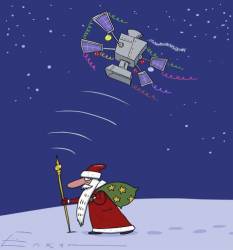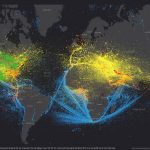 GLONASS Tracks Father Frost
GLONASS Tracks Father FrostAs GLONASS approaches completion, it’s no surprise that the Russian counterpart to GPS has gotten into more popular applications of GNSS technology — even Santa-tracking.
For more than 50 years, the North American Air Defense Command (NORAD) has followed the travels of the Christmas gift-bearer from his North Pole headquarters. The Santa-tracking operation can be viewed online.
As GLONASS approaches completion, it’s no surprise that the Russian counterpart to GPS has gotten into more popular applications of GNSS technology — even Santa-tracking.
For more than 50 years, the North American Air Defense Command (NORAD) has followed the travels of the Christmas gift-bearer from his North Pole headquarters. The Santa-tracking operation can be viewed online.
On November 18, the more secular Russian gift-giver, Ded Moroz or Father Frost, got into the act (on the traditional date of his birthday) with the backing of a commercial firm, Russian Navigation Technologies. The company presented Father Frost with staff bearing an integrated GLONASS receiver.
According to the company, the system will transmit Father Frost’s coordinates to a special center, which will publish them on the Internet so that everyone can follow his progress on his traditional New Year voyage.
According to NORAD, its tradition began in 1955 after a Colorado Springs-based Sears Roebuck & Co. advertisement for children to call Santa misprinted the telephone number. Instead of reaching Santa, the phone number put kids through to the operations “hotline” of the Continental Air Defense Command (CONAD) commander-in-chief.
As the calls came in, Col. Harry Shoup, director of operations at the time, had his staff check the radar for indications of Santa making his way south from the North Pole. Children who called were given updates on his location, and a tradition was born.
Shoup died last year at the age of 91, but his tradition lives on.
When Canada and the United States created a bi-national air defense command for North America in 1958, NORAD took on the tradition of tracking Santa. Since then, NORAD men, women, family, and friends have volunteered to personally respond to phone calls and e-mails from children all around the world.
NORAD uses four high-tech systems to track Santa – radar, satellites, Santa Cams and fighter jets. Details can be found here.
A video of last year’s Santa tracker shows an animated Santa and reindeer-drawn sled can be seen visiting Sydney, Australia; Seattle, Washington, and St. Louis, Missouri, USA; London, England; Taj Mahal, India; and other well-nown sites.
As for Father Frost, according to an RIA:Novosti article on the subject, November 18 is considered to be Father Frost’s birthday, and the city of Velikiy Ustyug in Russia’s north, his birthplace. But despite being some thousands of years old, Ded Moroz appears to be an early adapter of Russian technology.
“Technical innovations have become an essential part of modern life,” said Ivan Nechayev, executive director of the Russian Navigation Technologies. “Therefore, Father Frost has mastered computer skills, receives e-mails from children, has blogs in social networks and uses a cell phone to communicate with other magicians." The GLONASS module installed in the crystal-shaped top of Father Frost’s staff, which is reportedly 180 centimeters long and weighs some kilograms.
This year, Ded Moroz intends to visit about 30 Russian cities, from Yakutsk (on November 21) to St. Petersburg (on December 30).




